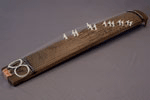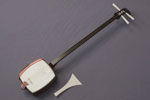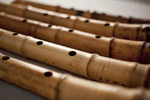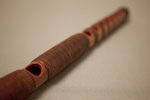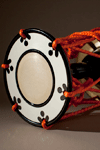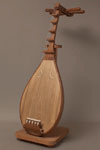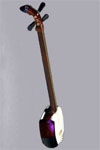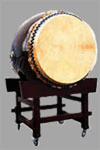
FUE
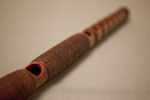
Japan has a wide range of transverse flutes, proof one might say, of their popularity.
In gagaku, Japanese imperial court music there are three types of transverse flute – ryūteki, komabue and kagurabue – with the most common, ryūteki, used in “music of the left” (tōgaku) and saibara, a genre of accompanied vocal music from the Heian court (9th-12th centuries CE). Transverse flutes used in Japanese Noh plays are called nōkan, and have an irregular scale due to the unique construction of the throat of the instrument. Shinobue, also called ‘bamboo flutes,’ used in kabuki theatre and folkloric performance arts are of simple bamboo construction, yet come in a range of lengths. Both ryūteki and nōkan have seven finger holes, komabue and kagurabue have six finger holes, and shinobue has either six or seven finger holes.
For Japanese transverse flutes there is a mnemonics technique, shōga, to memorize by singing a melody and chanting such syllables as o-hyā-rā.
Music Library
- Nanori bue
- Composer UNK*
- Year UNK*
- play
- Nōkan solo. Played when, on a Noh stage, a supporting character appears at the start of the performance.
- Ranjō and Shishigurui
- Composer UNK*
- Year UNK*
- play
- "Ranjō" – originally a gagaku term, yet a splendid musical introduction performed when a shishi, legendary lion, appears on stage in Noh plays and kabuki theatre. "Shishigurui" – Noh or kabuki dance depicting the frenzied play of the legendary lion and fox on "Shakkyō" or "Kokaji".
- Tori Kagura
- Composer UNK*
- Year UNK*
- play
- Hayashi, instrumental ensemble taking up walking after the passing rush of kagura, sacred Shinto dance. Evokes the auspicious atmosphere of festivals or New Year celebrations. Performed by shinobue (bamboo flute) and folk drums called okedō.
- Inaka bue and Sora bue
- Composer UNK*
- Year UNK*
- play
- Background music for kabuki dances of free playing shinobue (bamboo flute). Inaka bue evokes relaxed nostalgia, and Sora bue conjures feeling of sorrow.
*Composer UNK:Name of composer unknown. Year UNK:Year of composition unknown.
Performance by Kohei Nishikawa
In each episode, when staff notation is applicable, it is standardized by absolute pitch notation.






























